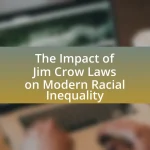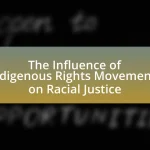The article examines the influence of global anti-colonial movements on American racial justice, highlighting how these movements provided a framework for solidarity and activism against systemic oppression. It discusses the historical emergence of anti-colonial movements, their goals, and the interconnectedness of these struggles with the American civil rights movement, particularly during the 1960s. Key events, strategies, and cultural exchanges are analyzed to illustrate how global anti-colonial ideologies shaped the discourse and practices of American racial justice activists. The article also addresses contemporary challenges and lessons learned from these historical movements, emphasizing the importance of international coalitions and grassroots organizing in the ongoing fight for racial equity.
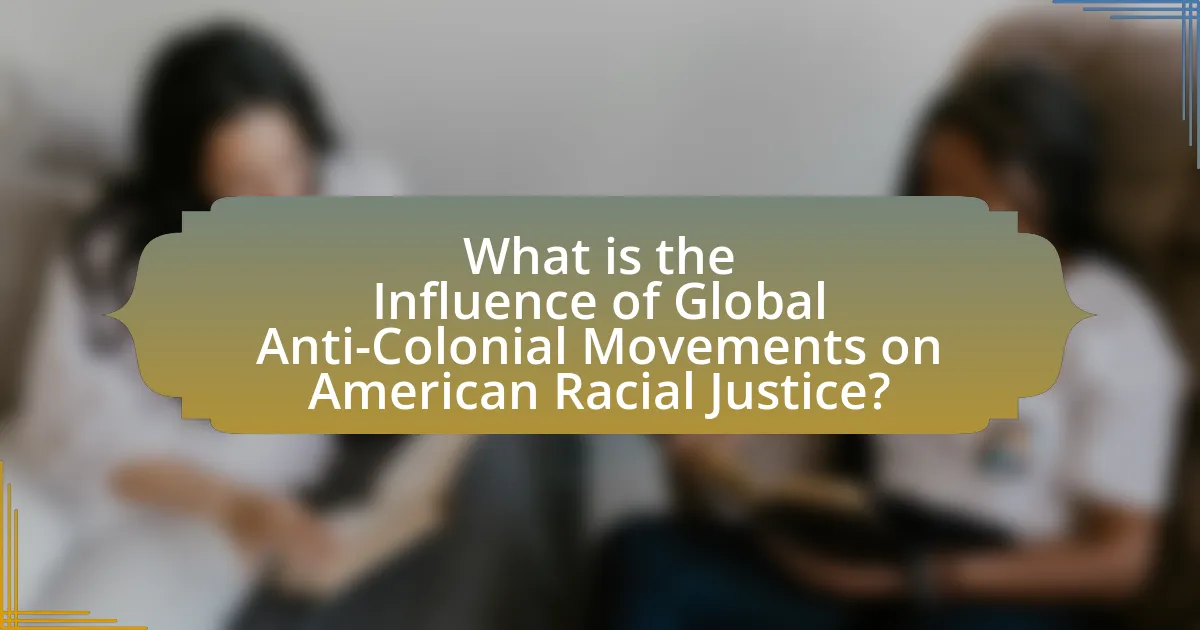
What is the Influence of Global Anti-Colonial Movements on American Racial Justice?
Global anti-colonial movements have significantly influenced American racial justice by providing a framework for solidarity and activism against systemic oppression. The civil rights movement in the United States, particularly during the 1960s, drew inspiration from anti-colonial struggles in Africa and Asia, where leaders like Kwame Nkrumah and Frantz Fanon articulated the need for liberation from colonial rule. This connection is evident in the writings of American civil rights leaders such as Martin Luther King Jr., who emphasized the global dimensions of justice and equality. Furthermore, the Black Power movement explicitly linked the fight against racial injustice in America to global anti-colonial efforts, advocating for a broader understanding of liberation that transcended national boundaries. The influence of these movements is also reflected in the adoption of strategies such as nonviolent resistance and grassroots organizing, which were pivotal in both contexts.
How did global anti-colonial movements emerge and what were their goals?
Global anti-colonial movements emerged primarily in the mid-20th century as a response to European colonial rule and imperialism, driven by a desire for self-determination, national sovereignty, and social justice. These movements were fueled by a combination of factors, including the impact of World War II, which weakened colonial powers, the spread of nationalist ideologies, and the influence of leaders such as Mahatma Gandhi and Kwame Nkrumah, who advocated for independence and civil rights. The goals of these movements included the end of colonial rule, the establishment of independent nation-states, and the promotion of social and economic equality for marginalized populations. For instance, the Indian independence movement successfully led to the end of British rule in 1947, while the African National Congress fought against apartheid in South Africa, highlighting the global struggle against colonial oppression and the quest for racial justice.
What historical contexts gave rise to these movements?
The historical contexts that gave rise to global anti-colonial movements include the aftermath of World War II, the rise of nationalism, and the civil rights struggles within colonized nations. Following World War II, many countries sought independence from colonial powers, fueled by the principles of self-determination and human rights articulated in the United Nations Charter of 1945. Nationalist leaders, such as Mahatma Gandhi in India and Kwame Nkrumah in Ghana, mobilized populations against colonial rule, inspiring similar movements worldwide. Additionally, the civil rights movements in the United States during the 1950s and 1960s drew parallels with anti-colonial struggles, as activists like Martin Luther King Jr. referenced global anti-colonial sentiments to advocate for racial justice. These interconnected historical contexts illustrate how the quest for independence and equality influenced both global and American movements for racial justice.
How did these movements articulate their demands for justice?
Global anti-colonial movements articulated their demands for justice through organized protests, written manifestos, and international solidarity campaigns. These movements, such as those led by figures like Martin Luther King Jr. and Malcolm X, drew parallels between their struggles and the anti-colonial efforts in Africa and Asia, emphasizing shared experiences of oppression. For instance, the Civil Rights Movement in the United States adopted rhetoric and strategies from anti-colonial leaders, advocating for equality and human rights as fundamental entitlements. The use of powerful imagery and speeches, such as King’s “I Have a Dream,” resonated with global audiences, highlighting systemic injustices and calling for immediate action. Additionally, the establishment of coalitions with international organizations, like the United Nations, further amplified their demands, showcasing a unified front against colonialism and racial discrimination.
In what ways did these movements impact American racial justice movements?
Global anti-colonial movements significantly influenced American racial justice movements by providing a framework for resistance and solidarity against oppression. These movements, such as the decolonization efforts in Africa and Asia during the mid-20th century, inspired American activists to draw parallels between their struggles for civil rights and the fight against colonial rule. For instance, leaders like Martin Luther King Jr. and Malcolm X referenced the anti-colonial struggles in their speeches, emphasizing the need for global solidarity among oppressed peoples. Additionally, the Pan-African Congress and the writings of figures like Frantz Fanon highlighted the psychological and systemic nature of oppression, which informed American activists’ understanding of racial injustice. This cross-pollination of ideas led to a more radical approach to civil rights, advocating for not just legal equality but also economic and social justice, as seen in the Black Power movement.
What parallels can be drawn between anti-colonial struggles and the Civil Rights Movement?
Anti-colonial struggles and the Civil Rights Movement share significant parallels, particularly in their fight against systemic oppression and the quest for self-determination. Both movements emerged in response to racial discrimination and colonial domination, with anti-colonial movements seeking independence from imperial powers while the Civil Rights Movement aimed to dismantle institutional racism in the United States.
For instance, leaders like Martin Luther King Jr. drew inspiration from anti-colonial figures such as Mahatma Gandhi, employing nonviolent resistance as a strategy to achieve civil rights. Additionally, both movements utilized grassroots organizing and mass mobilization to raise awareness and demand change, exemplified by events like the March on Washington and various decolonization protests worldwide.
The global context of anti-colonial struggles also influenced American activists, as the Civil Rights Movement coincided with decolonization in Africa and Asia during the mid-20th century, highlighting a shared narrative of liberation and justice. This interconnectedness underscores the universal fight against oppression, illustrating how anti-colonial struggles provided a framework for understanding and combating racial injustice in America.
How did international solidarity shape the strategies of American racial justice activists?
International solidarity significantly shaped the strategies of American racial justice activists by fostering a sense of global interconnectedness and shared struggle against oppression. Activists drew inspiration from anti-colonial movements worldwide, particularly during the mid-20th century, which emphasized the importance of collective action and solidarity across borders. For instance, the Civil Rights Movement in the United States was influenced by the decolonization efforts in Africa and Asia, where leaders like Martin Luther King Jr. publicly aligned with figures such as Nelson Mandela and Kwame Nkrumah, advocating for a unified approach to combat racial injustice. This transnational exchange of ideas and strategies was evident in the adoption of tactics such as nonviolent resistance and grassroots organizing, which were hallmarks of both American civil rights efforts and global anti-colonial campaigns. The collaboration and mutual support among activists across nations not only amplified their voices but also provided a broader context for understanding racial injustice as a global issue, thereby enhancing the effectiveness of their strategies.
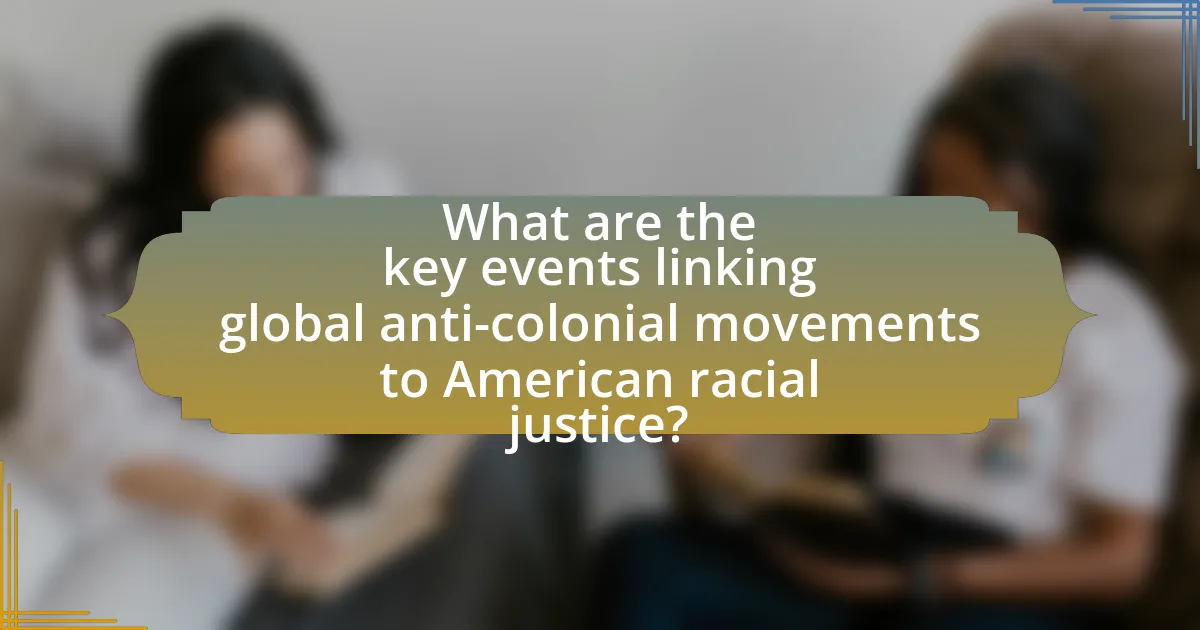
What are the key events linking global anti-colonial movements to American racial justice?
Key events linking global anti-colonial movements to American racial justice include the Pan-African Congresses, particularly the 1945 Manchester Congress, which united leaders from various countries advocating for independence and civil rights. This congress emphasized the interconnectedness of struggles against colonialism and racism, influencing American civil rights leaders like W.E.B. Du Bois and Paul Robeson. Additionally, the decolonization movements in Africa and Asia during the mid-20th century inspired American activists, as seen in the Civil Rights Movement of the 1960s, where figures like Martin Luther King Jr. drew parallels between their fight for equality and the global anti-colonial struggle. The 1963 March on Washington also showcased solidarity with global movements, highlighting the shared goals of freedom and justice. These events collectively illustrate how international anti-colonial efforts shaped the discourse and strategies of American racial justice movements.
Which significant events marked the intersection of these movements?
Significant events that marked the intersection of global anti-colonial movements and American racial justice include the 1963 March on Washington and the 1964 Civil Rights Act. The March on Washington, where Martin Luther King Jr. delivered his “I Have a Dream” speech, was influenced by global decolonization efforts, highlighting the struggle for civil rights alongside anti-colonial sentiments. The Civil Rights Act, which aimed to end discrimination based on race, color, religion, sex, or national origin, was also shaped by the global context of anti-colonial movements, as activists drew parallels between their struggles and those of colonized nations seeking independence. These events exemplify the interconnectedness of the fight for racial justice in the United States and the broader global anti-colonial struggle.
How did the Bandung Conference influence American activists?
The Bandung Conference significantly influenced American activists by providing a framework for anti-colonial solidarity and racial justice. The conference, held in 1955, brought together leaders from newly independent African and Asian nations, emphasizing the importance of self-determination and opposition to imperialism. This message resonated with American civil rights activists, who drew parallels between their struggles against racial discrimination and the global fight against colonialism. Notably, figures like Martin Luther King Jr. and Malcolm X referenced the conference’s principles, using them to advocate for civil rights and social justice in the United States. The conference’s emphasis on unity among oppressed peoples inspired American activists to broaden their perspectives and connect their local struggles to global movements for liberation.
What role did the anti-apartheid movement play in shaping American racial justice discourse?
The anti-apartheid movement significantly influenced American racial justice discourse by highlighting systemic racism and fostering solidarity among marginalized communities. Activists in the United States drew parallels between apartheid in South Africa and racial discrimination in America, which galvanized public opinion and led to increased activism against racial injustice domestically. For instance, the movement inspired the formation of coalitions such as the American Anti-Apartheid Movement, which organized protests and advocated for divestment from companies operating in South Africa. This activism contributed to the broader civil rights movement, emphasizing the interconnectedness of global struggles against oppression and shaping policies that addressed racial inequality in the U.S.
How did cultural exchanges between these movements manifest?
Cultural exchanges between global anti-colonial movements and American racial justice manifested through shared ideologies, artistic expressions, and solidarity actions. For instance, the Civil Rights Movement in the United States drew inspiration from anti-colonial leaders like Kwame Nkrumah and Nelson Mandela, who emphasized the fight against oppression and the quest for equality. This connection was evident in the adoption of rhetoric and strategies, such as nonviolent protest and civil disobedience, which were influenced by global movements. Additionally, cultural artifacts like music, literature, and visual art reflected these exchanges; for example, the works of artists like Nina Simone and James Baldwin incorporated themes of anti-colonialism and racial justice, bridging the experiences of oppressed peoples worldwide. These interactions not only enriched the American struggle for civil rights but also fostered a sense of global solidarity among marginalized communities.
What artistic expressions emerged from the collaboration between global and American activists?
Artistic expressions that emerged from the collaboration between global and American activists include visual art, music, literature, and performance art. These forms of expression often conveyed messages of resistance, solidarity, and social justice, reflecting shared struggles against oppression. For instance, the Black Arts Movement in the United States drew inspiration from anti-colonial movements worldwide, leading to the creation of powerful poetry and theater that addressed racial inequality and cultural identity. Additionally, collaborative music projects, such as those involving African and American artists, highlighted themes of unity and resistance, exemplified by songs that became anthems for civil rights and anti-colonial struggles. These artistic expressions served not only as a means of cultural exchange but also as tools for activism, amplifying the voices of marginalized communities and fostering a global dialogue on justice and equality.
How did literature and media contribute to the understanding of racial justice in America?
Literature and media significantly contributed to the understanding of racial justice in America by providing platforms for marginalized voices and highlighting systemic injustices. Works such as “The Souls of Black Folk” by W.E.B. Du Bois and “Invisible Man” by Ralph Ellison exposed the realities of racial discrimination and the complexities of African American identity, fostering empathy and awareness among broader audiences. Additionally, media coverage of events like the Civil Rights Movement, particularly through televised broadcasts and print journalism, brought national attention to issues such as segregation and police brutality, influencing public opinion and policy changes. The portrayal of these struggles in literature and media not only documented the fight for racial equality but also inspired activism and solidarity, illustrating the interconnectedness of local and global movements for justice.
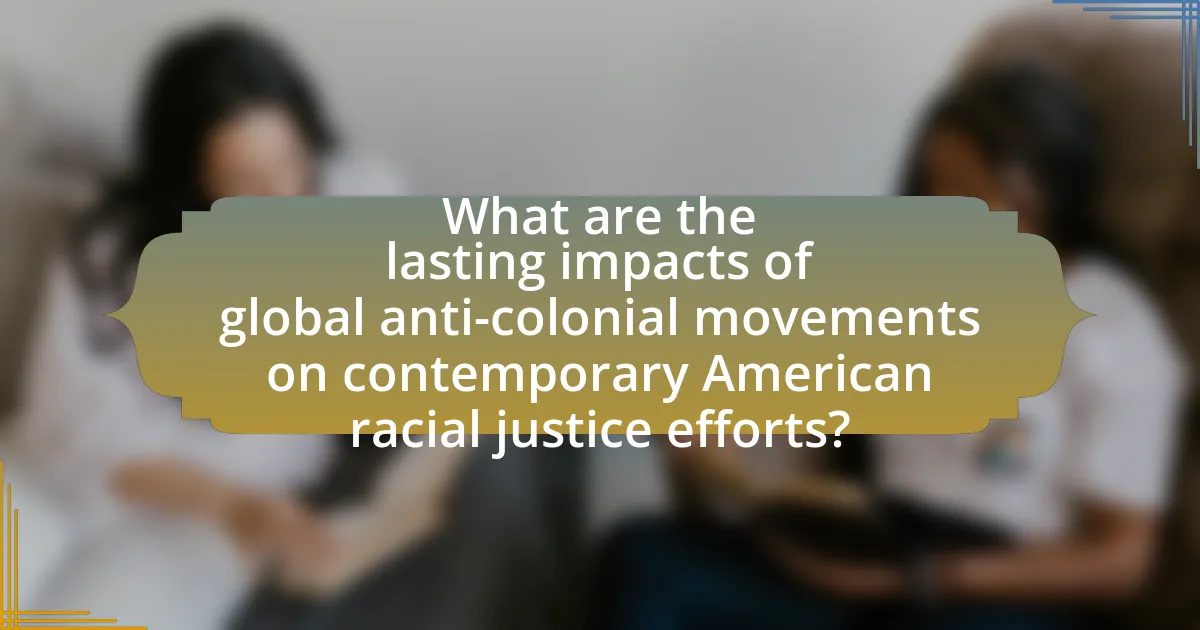
What are the lasting impacts of global anti-colonial movements on contemporary American racial justice efforts?
Global anti-colonial movements have significantly influenced contemporary American racial justice efforts by providing a framework for solidarity, resistance, and the articulation of racial and social justice issues. These movements, particularly during the mid-20th century, inspired American activists by highlighting the interconnectedness of struggles against oppression, as seen in the Civil Rights Movement, which drew parallels between domestic racial injustices and global anti-colonial struggles.
For instance, leaders like Martin Luther King Jr. and Malcolm X referenced anti-colonial figures such as Mahatma Gandhi and Frantz Fanon, emphasizing the need for a global perspective on racial justice. The Black Panther Party also adopted anti-colonial rhetoric, framing their fight against systemic racism as part of a broader struggle against imperialism.
Moreover, the influence of global anti-colonial movements is evident in contemporary movements like Black Lives Matter, which advocate for racial equity while recognizing the global dimensions of racial oppression. This interconnectedness is reinforced by the use of social media, allowing for the rapid dissemination of ideas and solidarity across borders, echoing the strategies employed by anti-colonial activists.
Thus, the lasting impacts of global anti-colonial movements manifest in the strategies, rhetoric, and solidarity practices of contemporary American racial justice efforts, demonstrating a continuous lineage of resistance against oppression.
How do current racial justice movements draw inspiration from anti-colonial ideologies?
Current racial justice movements draw inspiration from anti-colonial ideologies by emphasizing the interconnectedness of struggles against systemic oppression and colonial legacies. These movements adopt principles such as self-determination, collective resistance, and the critique of imperialism, which are central to anti-colonial thought. For instance, the Black Lives Matter movement aligns with anti-colonial ideologies by advocating for the rights and dignity of marginalized communities, paralleling the historical struggles of colonized peoples against oppressive regimes. Additionally, activists often reference figures like Frantz Fanon and Angela Davis, who articulate the necessity of dismantling colonial structures to achieve true liberation, thereby reinforcing the relevance of anti-colonial frameworks in contemporary racial justice efforts.
What strategies from global movements are being utilized today in America?
Strategies from global movements being utilized today in America include grassroots organizing, coalition-building, and the use of social media for mobilization. Grassroots organizing, inspired by movements such as the anti-apartheid struggle in South Africa, emphasizes community engagement and local leadership to address systemic injustices. Coalition-building, reflecting the strategies of global feminist movements, fosters alliances across various social justice issues, enhancing collective power. Additionally, social media platforms, utilized effectively during the Arab Spring, serve as tools for rapid information dissemination and mobilization, allowing activists to reach wider audiences and coordinate actions efficiently. These strategies demonstrate the direct influence of global anti-colonial movements on contemporary American racial justice efforts.
How do contemporary activists address the legacy of colonialism in their work?
Contemporary activists address the legacy of colonialism by integrating anti-colonial frameworks into their advocacy for racial justice. They emphasize the historical connections between colonialism and systemic racism, highlighting how colonial practices have shaped contemporary social inequalities. For instance, activists often reference the work of scholars like Frantz Fanon and Angela Davis, who articulate the links between colonial oppression and racial discrimination. Additionally, movements such as Black Lives Matter draw parallels between the struggles against colonialism in global contexts and the fight against police violence and systemic racism in the United States, thereby fostering a transnational solidarity that acknowledges shared histories of oppression.
What challenges do American racial justice movements face in relation to global anti-colonial influences?
American racial justice movements face challenges in aligning their goals with global anti-colonial influences due to differing historical contexts and priorities. While global anti-colonial movements often focus on decolonization and national sovereignty, American racial justice movements primarily address systemic racism and social inequality within a framework of civil rights. This divergence can lead to misunderstandings and conflicts over strategies and objectives. For instance, the emphasis on intersectionality in American movements may not always resonate with anti-colonial narratives that prioritize national identity over individual rights. Additionally, the global perception of American racial issues can sometimes overshadow local struggles, complicating solidarity efforts. These challenges highlight the complexities of integrating diverse anti-colonial perspectives into the American racial justice framework.
How do differing priorities among movements complicate solidarity efforts?
Differing priorities among movements complicate solidarity efforts by creating conflicts in goals and strategies. For instance, anti-colonial movements may prioritize national sovereignty and self-determination, while racial justice movements in America might focus on systemic racism and police brutality. This divergence can lead to misunderstandings and a lack of unified action, as seen in historical contexts where movements have struggled to align their objectives, such as during the civil rights era when some activists felt that international anti-colonial struggles detracted from domestic issues. Consequently, these differing priorities can hinder collaborative efforts, making it challenging to build a cohesive front against shared oppressions.
What are the risks of appropriation versus genuine solidarity in these contexts?
The risks of appropriation versus genuine solidarity in the context of global anti-colonial movements influencing American racial justice include the potential for exploitation of marginalized cultures and the dilution of authentic movements. Appropriation often manifests when dominant groups adopt elements of a marginalized culture without understanding or respecting its significance, leading to commodification and erasure of the original context. For instance, the use of cultural symbols in commercial products can undermine the struggles of those who originally fought for their meaning. In contrast, genuine solidarity involves active support and allyship, which can empower marginalized communities and amplify their voices. However, if not approached with sensitivity, even well-intentioned solidarity can risk overshadowing the narratives of those directly affected, as seen in instances where allies dominate discussions instead of listening to marginalized voices. This dynamic can perpetuate existing power imbalances, ultimately hindering the progress of racial justice initiatives.
What practical lessons can be learned from the influence of global anti-colonial movements on American racial justice?
The practical lessons learned from the influence of global anti-colonial movements on American racial justice include the importance of solidarity, the effectiveness of grassroots organizing, and the necessity of intersectionality in social justice efforts. Solidarity is exemplified by the collaboration between African American leaders and anti-colonial activists, such as W.E.B. Du Bois, who emphasized the interconnectedness of struggles against oppression. Grassroots organizing, as seen in movements like the Black Panther Party, drew inspiration from global anti-colonial strategies, demonstrating that local action can have a global impact. Additionally, the concept of intersectionality, highlighted by activists like Kimberlé Crenshaw, underscores the need to address multiple forms of discrimination, reflecting the diverse experiences within both racial justice and anti-colonial contexts. These lessons illustrate how global movements can inform and strengthen local struggles for racial equity in the United States.
How can activists effectively build international coalitions for racial justice?
Activists can effectively build international coalitions for racial justice by leveraging shared goals, utilizing digital platforms for communication, and fostering relationships with local organizations. Shared goals create a unified vision, as seen in the collaboration between movements like Black Lives Matter and anti-colonial groups, which emphasizes common struggles against systemic oppression. Digital platforms, such as social media, facilitate real-time communication and mobilization across borders, exemplified by global protests that occurred in response to the George Floyd incident in 2020, where activists worldwide expressed solidarity. Additionally, establishing partnerships with local organizations ensures that coalitions are grounded in the specific contexts and needs of communities, enhancing the effectiveness of collective actions. This approach not only amplifies voices but also builds a diverse and inclusive movement for racial justice on an international scale.
What best practices can be adopted from historical anti-colonial movements?
Best practices that can be adopted from historical anti-colonial movements include grassroots mobilization, coalition-building, and the use of nonviolent resistance. Grassroots mobilization, as seen in India’s struggle for independence led by Mahatma Gandhi, emphasizes the importance of engaging local communities to create a broad base of support. Coalition-building, exemplified by the African National Congress in South Africa, showcases the effectiveness of uniting diverse groups to strengthen the movement’s impact. Nonviolent resistance, demonstrated by figures like Martin Luther King Jr. in the American Civil Rights Movement, highlights the power of peaceful protest to challenge oppressive systems and garner public sympathy. These practices have proven effective in achieving social change and can be instrumental in contemporary movements for racial justice.

